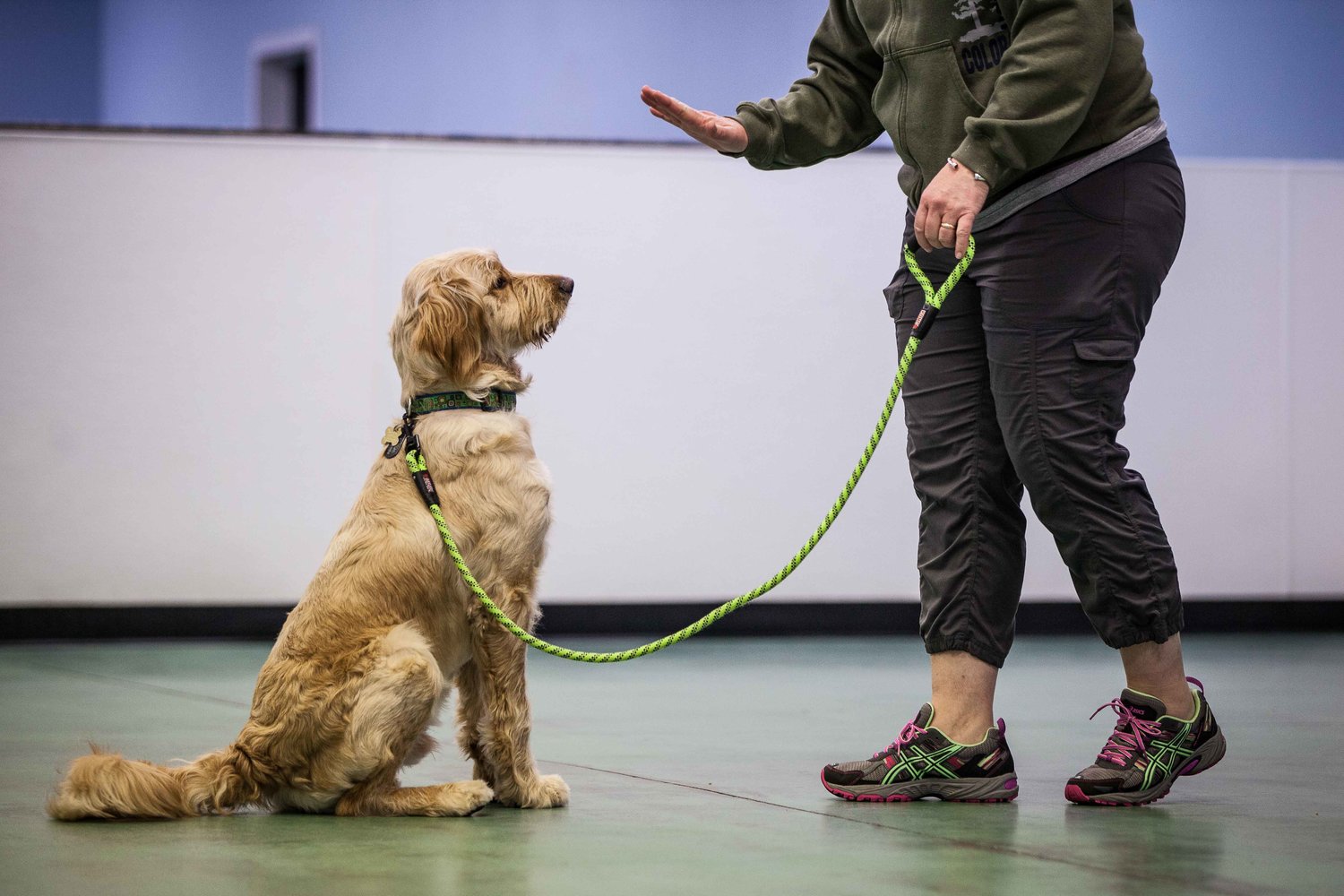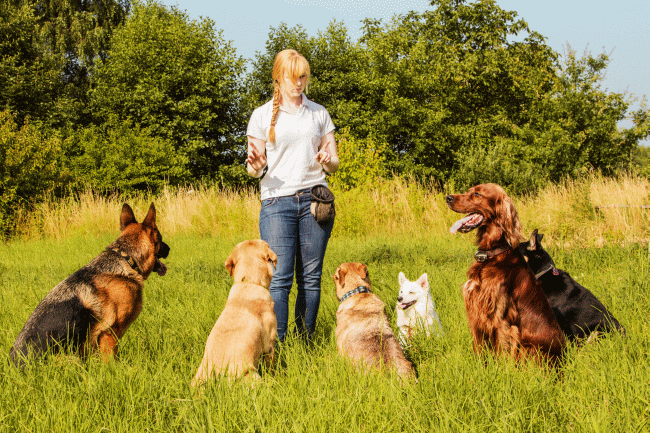Dog Training Rochester NY: Tailored Solutions for Every Dog's Needs
Wiki Article
Newbie's Guide to Successful Dog Training in the house
Successfully training a pet dog at home needs a nuanced understanding of canine habits and effective communication approaches. Developing clear training objectives, using top quality benefits, and preserving consistency across family participants are crucial components. Incorporating training right into everyday regimens can enhance both involvement and retention.Understanding Pet Dog Habits
Understanding pet dog habits is necessary for efficient training and promoting a harmonious connection in between human beings and their canine companions - Puppy Training. Dogs interact primarily with body language, articulations, and faces, making it vital for owners to interpret these signals properly. Acknowledging behaviors such as tail wagging, grumbling, or cring can provide understandings right into a dog's mood and objectivesMoreover, recognizing the all-natural reactions of pet dogs, such as their pack mindset, assists owners establish leadership duties within the home. This is essential for producing a structured atmosphere where dogs feel secure and are extra responsive to training. Canines are additionally affected by their socializing experiences; early direct exposure to various atmospheres, individuals, and other pets can considerably shape their actions later in life.
Typical behavior issues, such as hostility, anxiousness, or too much barking, frequently stem from misconceptions or unmet demands. Observing and resolving these issues immediately can protect against acceleration and make certain a positive training experience. By fostering a deep understanding of canine actions, proprietors can customize their training techniques to suit their canine companions, eventually causing a mannerly and contented animal.

Vital Training Tools
A well-appointed training room can dramatically improve the effectiveness of dog training in the house. Necessary training tools make certain that both the fitness instructor and the dog can participate in effective sessions that promote knowing and bonding.
Purchasing a tough chain and a comfortable, well-fitting collar or harness is vital for safety and control. These tools help establish boundaries and ensure the canine stays safe during training. Furthermore, an assigned training location, without disturbances, help focus for both the pet and the fitness instructor.
Training help such as training pads, cones, or dexterity devices can also improve the experience by presenting variety and difficulties. Finally, having a notebook or digital app for tracking progress can be important, allowing you to keep in mind successes and areas for improvement. Using these vital tools will certainly develop a favorable training atmosphere and lay the foundation for reliable discovering.
Creating an Educating Regimen
Establishing a consistent training regimen is crucial for efficient dog training in the house. A well-structured routine not only aids in strengthening desired behaviors but additionally offers your pet with a feeling of safety and security and predictability. To create an effective training routine, begin by recognizing specific training objectives, such as fundamental commands, chain walking, or housebreaking.Pick a designated time daily for training sessions, ideally when your pet dog is responsive and sharp. Sessions must be short, around 5 to 15 mins, to keep focus and avoid fatigue. Uniformity in timing and environment will improve your dog's understanding experience.
Incorporate training into everyday tasks to reinforce skills. Technique commands during strolls or nourishment, which incorporates learning into all-natural regimens. In addition, continue to be adaptable and change the regular as essential, fitting your pet's power degrees and mood.
Positive Support Methods

When implementing favorable reinforcement, it is necessary to pick benefits that are motivating for your pet dog. High-value treats, such as small items of chicken or cheese, can be especially effective throughout training sessions. Furthermore, differing the benefits can maintain your canine's interest and interest.
Beginning with easy commands, like "sit" or "stay," and progressively progress to a lot more complicated jobs. Consistency is essential; guarantee that all relative utilize the same commands and reward systems to stay clear of confusion.
Additionally, it is vital to continue to be client and prevent aggravation. Dogs, like people, find out at their own pace. By cultivating a helpful training environment with positive reinforcement, you can enhance your pet dog's discovering experience while reinforcing the bond between you and your furry buddy, helpful site preparing for successful training results.
Typical Educating Challenges
While educating a pet dog in the house can be a gratifying experience, it frequently includes a set of typical difficulties that can evaluate both persistence and uniformity. One common problem is diversion. Canines my link might come to be easily sidetracked by noises, motions, and even aromas in their environment, making it difficult to keep their emphasis throughout training sessions.Another challenge is inconsistency in commands and reinforcement. If household participants utilize different cues or incentives, it can perplex the pet and impede development. Establishing a unified method is necessary for effective communication.
Furthermore, pet dogs can experience aggravation or stress, especially if they do not recognize what is anticipated of them. This can bring about unfavorable behaviors, such as barking or chewing.
Lastly, the timing of reinforcement is essential. Postponed incentives can decrease the effectiveness of favorable reinforcement, as canines might stop working to connect the actions with the incentive.
Getting over these difficulties requires dedication, clear communication, and an organized training plan - Puppy Training. Identifying and dealing with these common barriers will lead the method for a more effective and pleasurable training experience at home
Verdict
In verdict, effective pet dog training at home requires a detailed understanding of canine habits and efficient communication strategies. By establishing clear training objectives and making use of high-quality deals with along with favorable support, the training procedure ends up being a lot more satisfying for both the pet dog and the instructor.
Developing a regular training regimen is crucial for effective canine training at home.Favorable reinforcement techniques are basic to efficient dog training, advertising preferred actions with rewards rather than punishment. By cultivating a supportive training setting through favorable support, you can improve your canine's learning experience while reinforcing the bond between you and your furry companion, laying the foundation for effective training outcomes.
In verdict, effective pet training at home requires a comprehensive understanding of canine habits and effective communication strategies. By establishing clear training goals and making use of top weblink notch deals with alongside favorable reinforcement, the training procedure becomes much more rewarding for both the trainer and the canine.
Report this wiki page